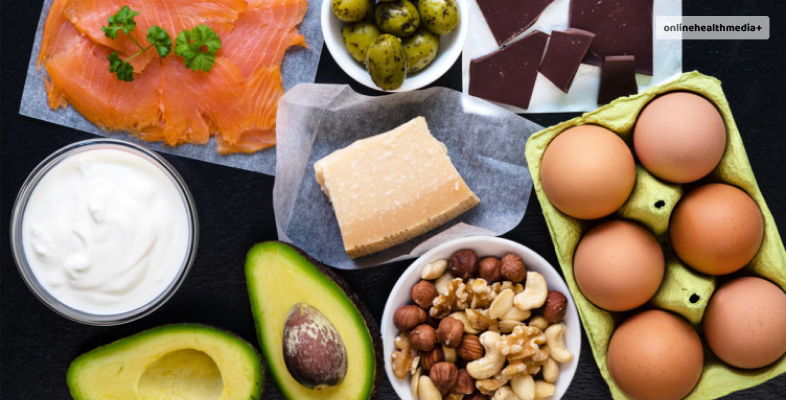Here Is Why Cyclical Ketogenic Diet Is Essential For Athletes
The Cyclical Ketogenic Diet (CKD) is a variation of the standard ketogenic diet (SKD), which is a high-fat, low-carbohydrate diet that encourages the body to enter a state of ketosis.
Ketosis is a metabolic state in which the body primarily uses fat for energy because it has limited access to carbohydrates.
The CKD, however, introduces periods of higher carbohydrate consumption into the ketogenic diet, typically cyclically.
To learn more about this ketogenic diet, read this post until the end.
How Does Cyclical Ketogenic Diet Work?

Here’s how the cyclical ketogenic diet for weight loss works:
1. Ketogenic Phase
The cyclical ketogenic diet starts with a period of strict adherence to the ketogenic diet, similar to the SKD. During this phase, carbohydrate intake is kept very low, usually below 50 grams of net carbs per day.
The primary energy source during this phase is dietary fat, and the body produces ketones from fat breakdown, which are used for fuel.
2. Carb Loading Phase
Unlike the SKD, the cyclical ketogenic diet includes a carb-loading phase, typically occurring once a week or every few days, depending on the individual’s plan.
During this phase, individuals significantly increase their carbohydrate intake, often consuming several hundred grams of carbs daily.
The goal of the carb-loading phase is to temporarily replenish glycogen stores in the muscles and liver, providing a burst of energy for high-intensity workouts or athletic performance
3. Exercise Timing
The carb-loading phase is strategically timed to coincide with intense workouts or physical activities. The idea is to use the increased glycogen stores to enhance performance.
4. Cycling
The cyclical ketogenic diet follows a cyclical pattern, with alternating keto carb cycling of strict ketogenic eating and carb loading. The duration of each phase can vary from one individual to another, but it typically involves several days of strict keto followed by a carb-loading day.
5. Variations
There are different variations of carb cycling keto, with some individuals opting for longer keto phases and shorter carb-loading periods, while others may have more frequent carb-loading days.
Who Is Cyclical Ketogenic Diet For?

Carb cycling on keto is primarily designed for specific groups of individuals with particular goals and requirements. It may only suit some, unlike the Hashimoto and standard vegan diets.
Here’s a breakdown of who the cyclical ketogenic diet may be intended for:
1. Athletes And Bodybuilders
The cyclical ketogenic diet is often used by athletes and bodybuilders who engage in high-intensity workouts, strength training, or endurance sports. The carb-loading phases can temporarily boost glycogen stores, enhancing performance during training or competitions.
2. Strength Athletes
Strength athletes who want to maintain or increase muscle mass while following a ketogenic diet may find the cyclical ketogenic diet beneficial. The carb-loading phases can support muscle growth and recovery.
3. Endurance Athletes
Some endurance athletes, such as long-distance runners or cyclists, may use the cyclical ketogenic diet to improve endurance during races or long training sessions. Carbohydrates can provide sustained energy for prolonged efforts. A gluten free diet also works well for such athletes.
4. Fitness Enthusiasts
Individuals who follow a ketogenic diet for health or weight management reasons but want to enjoy occasional carbohydrate-rich meals without leaving ketosis may adopt the cyclical ketogenic diet for dietary flexibility.
5. People With High Energy Expenditure
Individuals with physically demanding jobs or hobbies requiring a lot of energy may benefit from CKD. Carb-loading phases provide extra energy for these activities.
6. People Seeking Psychological Relief
Some people find the strictness of a standard ketogenic diet (SKD) challenging to maintain over the long term. The CKD’s periodic carb-loading can offer psychological relief by allowing occasional indulgence in carbohydrate-rich foods. The lipedema diet and Dukan diet work well here as well.
7. Muscle Preservation During Cutting Phases
Bodybuilders and fitness competitors in cutting phases (where they reduce body fat for competitions) may use the cyclical ketogenic diet to help preserve muscle mass while still achieving fat loss.
8. Metabolic Flexibility Enthusiasts
Individuals interested in metabolic flexibility, which means the ability to switch between using carbohydrates and fats for energy, may adopt the cyclical ketogenic diet as it promotes this flexibility.
What Are The Benefits Of Cyclical Ketogenic Diet?

Although CKD offers several potential benefits, it may only suit some. Here’s a detailed look at the benefits of the CKD:
1. Enhanced Athletic Performance
One of the primary advantages of the cyclical ketogenic diet is its potential to boost athletic performance. By replenishing glycogen stores during carb-loading phases, individuals can have more energy for high-intensity workouts or sports activities.
2. Muscle Growth And Preservation
The cyclical ketogenic diet results in muscle growth and preservation. Adequate carbohydrate intake during carb-loading phases can provide the necessary energy for muscle building and repair.
3. Flexible Dieting
The cyclical ketogenic diet’s cyclical nature allows for more dietary flexibility compared to the standard ketogenic diet (SKD), which requires strict adherence to low-carb eating. This can make it more sustainable for some people.
4. Psychological Benefits
The CKD’s periodic carb-loading phases can alleviate the mental and emotional stress associated with long-term adherence to a strict ketogenic diet, as individuals can occasionally enjoy their favorite carbohydrate-rich foods.
5. Endurance Workouts
Athletes who engage in endurance sports, such as long-distance running or cycling, may benefit from the CKD’s carb-loading phases. Carbohydrates can improve endurance and reduce the risk of “hitting the wall.”
6. Hormone Regulation
Some proponents suggest that the CKD’s cycling of carbohydrates may help regulate metabolism-related hormones, such as leptin and thyroid hormones, potentially preventing the metabolic slowdown seen in long-term calorie-restricted diets.
7. Metabolic Flexibility
The cyclical ketogenic diet encourages metabolic flexibility, allowing the body to switch between efficiently utilizing carbohydrates and fats for energy. This can be advantageous for those who want to maintain both a ketogenic state and the ability to use carbohydrates when needed.
8. Reduced Side Effects
Some people experience side effects like the “keto flu” when initially transitioning to a strict ketogenic diet. The CKD’s carb-loading phases can provide relief from these symptoms.
9. Enjoyment Of Carbohydrate Foods
People who miss eating carb-rich foods can benefit from occasional carb-loading days on the CKD. This may improve dietary adherence.
10. Preservation Of Strength
For strength athletes and bodybuilders, the CKD’s carb-loading phases may help maintain strength levels during cutting phases, often involving calorie restriction.
Conclusion
It is important to emphasize that you should follow the cyclical ketogenic diet with careful planning and consideration of individual goals and responses.
It’s not recommended for those who are new to ketogenic diets or individuals with certain medical conditions, especially those related to blood sugar regulation.
Therefore, before you start CKD or any specialized diet, consulting with a healthcare professional or registered dietitian is advisable to ensure it aligns with specific health and fitness goals and to receive guidance on its implementation and monitoring.
Also Read
- Fund Your Business With A Medical Business Loan.
- Anxiety Got You Feeling Restless? Try Meditation For Anxiety!
- Rare Adipose Disorder? Here Are The Top 10 Benefits Of The Lipedema Diet.



